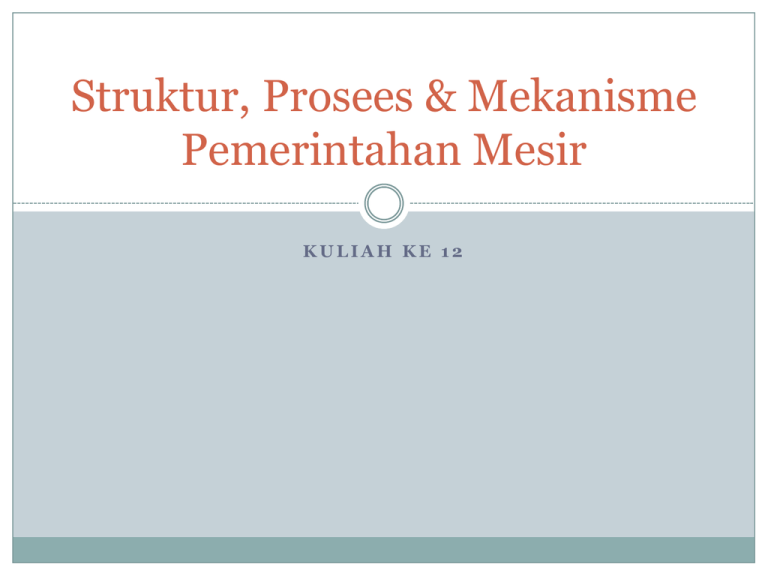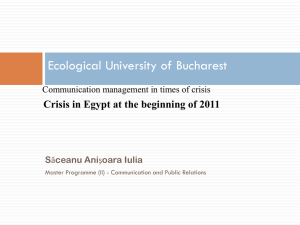Struktur, Prosees & Mekanisme Pemerintahan Mesir
advertisement

Struktur, Prosees & Mekanisme Pemerintahan Mesir KULIAH KE 12 Awal Bentuk Pemerintahan With 77 million people (2005 est.), Egypt is the most populous nation in the Arab world and commands the largest military force in the region. Located in the northeast corner of Africa, the country has historically been a crossroads for commerce, ideas, and conquerors. Muhammad Ali (1805–48), the maverick Ottoman governor, established a semiautonomous state and a hereditary line that would last until 1953. Egypt has been a republic since June 18, 1953, when the Revolutionary Command Council (RCC), the military junta that had seized power a year earlier on July 23, 1952, abolished the monarchy and appointed its figurehead leader, Muhammad Nagib, Egypt’s first president. Sistem Pemerintahan Egypt today is a “socialist democratic” republic ruled by an authoritarian president, Hosni Mubarak, who has governed since 1981. Since 1990 Egyptians have undertaken a dramatic reevaluation of the 1952 military coup that ushered in a social revolution and put the present political structures in place. Since the late 1970s the country has experimented with greater democratization, but facing challenges from an Islamist current that rejects key foundations of the state, it has yet to truly open up the political process. Eksekutif Ultimate power in Egypt resides in the president, who is chief executive and leader of the ruling National Democ ratic Party (NDP). Until 2005 the president was not elected by popular vote but rather was nominated by two-thirds of the People’s Assembly (Majlis alShaab), then approved by popular referendum. However, this changed with the presidential elections held in September 2005, which were the first to allow multiple candidates and the first to allow for direct popular vote. The president must be of Egyptian parentage and at least 40 years old. The 1971 constitution set the presidential term at six years and made provisions for another term. A 1980 constitutional amendment stated that the president may serve additional terms. Mubarak has subsequently been reapproved four times: in 1987, 1993, 1999, and 2005 (when he won the first direct election). Legislatif The People’s Assembly (National Assembly before 1971) approves general policy, the national budget, and devel opment plans. Until 2005 it also nominated the president. It may vote no confidence in any government minister, deputy minister, or deputy prime minister but has no power to vote no confidence in the prime minister. It may bring complaints against the prime minister before the president, who may then put the issue to a popular referendum. If the referendum fails, the president may dismiss the Assembly. This prerogative may be exercised at any time but must be followed by a popular referendum within 60 days. The People’s Assembly is composed of 454 deputies (numbers have fluctuated slightly since the 1980s). Each of Egypt’s 222 legislative districts is represented by two deputies. Dewan Syuro/ Penasehat In 1980 the Shura Council (Advisory Council) was established. The Council oversees and approves broad matters of policy but has no legislative authority. At present 140 of its 210 members are elected; the remaining members are presidential appointees. Elections to the Shura Council, held every three years, closely mirror elections to the Peo ple’s Assembly. Yudikatif According to the 1971 constitution, Islam is the state religion and the Sharia (Islamic legal code) the principal source of legislation. As in other parts of the former Ottoman Empire, however, the judicial and legal system has been modeled on European lines since the late 19th century. The jurisdiction of Sharia judges was curtailed as new criminal, civil, and commercial codes were drafted and a new legal establishment was trained along Western lines. The judiciary in Egypt is divided between courts of general jurisdiction and administrative courts. Sitting atop the system is the Supreme Constitutional Court that reviews the constitutionality of legal measures and re solves constitutional disputes. Courts of general jurisdiction begin at the district level. At least one tribunal of first instance, with civil and criminal chambers, is located in each of Egypt’s 26 governorates. Appellate courts, also with separate civil and criminal chambers, have jurisdiction over one or more governorates. Topping the system is the Court of Cassation in Cairo, which hears petitions from criminal and civil appellate courts. Administrative courts hear cases involving governmental agencies. The State Council, an independent judicial body, is empowered to render decisions in administrative disputes and cases within the legal system. The Supreme Judicial Council, abolished in 1969, then reinstated in 1984, is consulted with regard to draft laws that organize the affairs of other judicial bodies. Struktur Pemerintahan











